一、位运算
1.异或^
-
定义
11=0、10=1、01=1、00=0,无进位相加
-
性质:
-
0n=n nn=0
-
异或运算满足交换率,结合律
-
应用:
不创建新的变量就交换A和B的值(前提:A和B指向的内存是两块)
a = a ^ b; b = a ^ b; a = a ^ b; -
算法题:
-
一个数组中有奇数个a,剩余的数都是偶数个,找出这个奇数个的a的值
int eor = 0; 将eor与数组的数全部异或
-
一个数组只用两种数a,b出现了奇数次,剩下的出现偶数次
int eor = 0; 与数组的数全部异或,结果就是a^b
int eor2 = 0; 异或数组中某一位数为1的数(int rightOne = eor & (~eor+1) ),eor2 = a or b;
eor ^ eor2 = b or a;
public static void main(String[] args) { int[] arr = {1,1,1,3,3,3,3,2}; int ero = 0; for (int i : arr) { ero ^= i; } //ero = a ^ b int rightOne = ero & (~ero+1);//提取出最右的1 int ero2 = 0; for (int i : arr) { if ((i & rightOne) == 0){ ero2 ^= i; } } System.out.println(ero2+" "+(ero^ero2)); }
-
二、排序
1.选择排序
-
定义解释:选择排序(select sorting)也是一种简单的排序方法。它的基本思想是:第一次从arr[0]~arr[n-1]中选取最小值,与arr[0]交换,第二次从arr[1]~arr[n-1]中选取最小值,与arr[1]交换...总共通过n-1次,得到一个按排序码从小到大排列的有序序列。
-
时间复杂度:O(n²)
-
核心代码:
public static void selectionSort(int[] arr) { if (arr == null || arr.length < 2) { return; } for (int i = 0; i < arr.length - 1; i++) { int minIndex = i; for (int j = i + 1; j < arr.length; j++) { minIndex = arr[j] < arr[minIndex] ? j : minIndex; } swap(arr, i, minIndex); } } public static void swap(int[] arr, int i, int j) { int tmp = arr[i]; arr[i] = arr[j]; arr[j] = tmp; }
2.冒泡排序
-
时间复杂度:O(n²)
-
核心代码:
public static void bubbleSort(int[] arr) { if (arr == null || arr.length < 2) { return; } for (int e = arr.length - 1; e > 0; e--) { for (int i = 0; i < e; i++) { if (arr[i] > arr[i + 1]) { swap(arr, i, i + 1); } } } } public static void swap(int[] arr, int i, int j) { arr[i] = arr[i] ^ arr[j]; arr[j] = arr[i] ^ arr[j]; arr[i] = arr[i] ^ arr[j]; }
3.插入排序
-
过程演示 第1:13:58位置
-
基本思想:把n个待排序的元素看成为一个有序表和一个无序表,开始时有序表中只包含一个元素,无序表中包含有n-1个元素,排序过程中每次从无序表中取出第一个元素,把它的排序码依次与有序表元素的排序码进行比较,将它插入到有序表中的适当位置,使之成为新的有序表。
-
时间复杂度:O(n²)
-
核心代码:
public static void insertionSort(int[] arr) { if (arr == null || arr.length < 2) { return; } for (int i = 1; i < arr.length; i++) { for (int j = i - 1; j >= 0 && arr[j] > arr[j + 1]; j--) { swap(arr, j, j + 1); } } } public static void swap(int[] arr, int i, int j) { arr[i] = arr[i] ^ arr[j]; arr[j] = arr[i] ^ arr[j]; arr[i] = arr[i] ^ arr[j]; }
4.归并排序
-
过程演示 第34:53位置
-
时间复杂度O(N*logN)
-
代码演示:
public static void mergeSort(int[] arr) { if (arr == null || arr.length < 2) { return; } mergeSort(arr, 0, arr.length - 1); } public static void mergeSort(int[] arr, int l, int r) { if (l == r) { return; } int mid = l + ((r - l) >> 1); mergeSort(arr, l, mid); mergeSort(arr, mid + 1, r); merge(arr, l, mid, r); } public static void merge(int[] arr, int l, int m, int r) { int[] help = new int[r - l + 1]; int i = 0; int p1 = l; int p2 = m + 1; while (p1 <= m && p2 <= r) { help[i++] = arr[p1] < arr[p2] ? arr[p1++] : arr[p2++]; } while (p1 <= m) { help[i++] = arr[p1++]; } while (p2 <= r) { help[i++] = arr[p2++]; } for (i = 0; i < help.length; i++) { arr[l + i] = help[i]; } } -
算法题:
-
最小和问题
在一个数组中,每一个数左边比当前数小的数累加起来,叫做这个数组的小和。求一个数组的小和。
例子:[1,3,4,2,5] 1左边比1小的数,没有; 3左边比3小的数,1; 4左边比4小的数,1、3; 2左边比2小的数,1; 5左边比5小的数,1、3、4、2; 所以小和为1+1+3+1+1+3+4+2=16
左边最小和转化为右边最大和
-
逆序对
在一个数组中,左边的数如果比右边的数大,则折两个数构成一个逆序对,请打印所有逆序对。
-
5.快速排序
引入:荷兰国旗问题:过程演示 第1:45:39位置
-
给定一个数组arr,和一个数num,请把小于等于num的数放在数 组的左边,大于num的数放在数组的右边。要求额外空间复杂度O(1),时间复杂度O(N)
1.[i]<=num,[i]和<=区的下一个数交换,<=区扩一,i++
2.[i]>num,i++
-
给定一个数组arr,和一个数num,请把小于num的数放在数组的左边,等于num的数放在数组的中间,大于num的数放在数组的右边。要求额外空间复杂度O(1),时间复杂度 O(N)

-
时间复杂度:O(n²)
-
改进后
1)在数组范围中,等概率随机选一个数作为划分值,然后把数组通过荷兰国旗问题分成三个部分:
左侧<划分值、中间==划分值、右侧>划分值
2)对左侧范围和右侧范围,递归执行
3)时间复杂度为O(N*logN)public static void quickSort(int[] arr) { if (arr == null || arr.length < 2) { return; } quickSort(arr, 0, arr.length - 1); } public static void quickSort(int[] arr, int l, int r) { if (l < r) { swap(arr, l + (int) (Math.random() * (r - l + 1)), r); int[] p = partition(arr, l, r); quickSort(arr, l, p[0] - 1); quickSort(arr, p[1] + 1, r); } } public static int[] partition(int[] arr, int l, int r) { int less = l - 1; int more = r; while (l < more) { if (arr[l] < arr[r]) { swap(arr, ++less, l++); } else if (arr[l] > arr[r]) { swap(arr, --more, l); } else { l++; } } swap(arr, more, r); return new int[] { less + 1, more }; } public static void swap(int[] arr, int i, int j) { int tmp = arr[i]; arr[i] = arr[j]; arr[j] = tmp; }
6.堆排序
-
过程演示 第50:53位置
-
时间复杂度O(n*logn)
-
代码:
public static void heapSort(int[] arr) { if (arr == null || arr.length < 2) { return; } for (int i = 0; i < arr.length; i++) { heapInsert(arr, i); } int size = arr.length; swap(arr, 0, --size); while (size > 0) { heapify(arr, 0, size); swap(arr, 0, --size); } } public static void heapInsert(int[] arr, int index) { while (arr[index] > arr[(index - 1) / 2]) { swap(arr, index, (index - 1) /2); index = (index - 1)/2 ; } } public static void heapify(int[] arr, int index, int size) { int left = index * 2 + 1; while (left < size) { int largest = left + 1 < size && arr[left + 1] > arr[left] ? left + 1 : left; largest = arr[largest] > arr[index] ? largest : index; if (largest == index) { break; } swap(arr, largest, index); index = largest; left = index * 2 + 1; } } public static void swap(int[] arr, int i, int j) { int tmp = arr[i]; arr[i] = arr[j]; arr[j] = tmp; } -
算法题:
-
已知一个几乎有序的数组,几乎有序是指,如果把数组排好顺序的话,每个元素移动的距离可以不超过k,并且k相对于数组来说比较小。请选择一个合适的排序算法针对这个数据进行排序。
解法:准备小根堆,将数组k+1个数放到小根堆中,弹出堆顶。
public void sortedArrDistanceLessK(int[] arr, int k) { PriorityQueue<Integer> heap = new PriorityQueue<>(); int index = 0; for (; index < Math.min(arr.length, k); index++) { heap.add(arr[index]); } int i = 0; for (; index < arr.length; i++, index++) { heap.add(arr[index]); arr[i] = heap.poll(); } while (!heap.isEmpty()) { arr[i++] = heap.poll(); } }
-
7.基数排序
-
过程演示 第2:00:07位置
-
时间复杂度:O(N*K)
8.桶排序
过程演示 第2:11:12位置
public static void radixSort(int[] arr) {
if (arr == null || arr.length < 2) {
return;
}
radixSort(arr, 0, arr.length - 1, maxbits(arr));
}
public static int maxbits(int[] arr) {
int max = Integer.MIN_VALUE;
for (int i = 0; i < arr.length; i++) {
max = Math.max(max, arr[i]);
}
int res = 0;
while (max != 0) {
res++;
max /= 10;
}
return res;
}
public static void radixSort(int[] arr, int begin, int end, int digit) {
final int radix = 10;
int i = 0, j = 0;
int[] bucket = new int[end - begin + 1];
for (int d = 1; d <= digit; d++) {
int[] count = new int[radix];
for (i = begin; i <= end; i++) {
j = getDigit(arr[i], d);
count[j]++;
}
for (i = 1; i < radix; i++) {
count[i] = count[i] + count[i - 1];
}
for (i = end; i >= begin; i--) {
j = getDigit(arr[i], d);
bucket[count[j] - 1] = arr[i];
count[j]--;
}
for (i = begin, j = 0; i <= end; i++, j++) {
arr[i] = bucket[j];
}
}
}
public static int getDigit(int x, int d) {
return ((x / ((int) Math.pow(10, d - 1))) % 10);
}
9.排序总结
-
稳定性
排完序之后,是否保留之前数组的相对次序,比如第一个1仍在第二个1前面。
不具备稳定性的排序:选择排序、快速排序、堆排序
具备稳定性的排序:冒泡排序、插入排序、归并排序、一切桶排序思想下的排序
目前没有找到时间复杂度O(N*logN),额外空间复杂度O(1),又稳定的排序。

-
常见的坑
- 归并排序的额外空间复杂度可以变成O(1),但是非常难,不需要掌握,有兴趣可以搜“归并排序 内部缓存法”(会破坏稳定性,那为什么不用桶排序)
- “原地归并排序”的帖子都是垃圾,会让归并排序的时间复杂度变成O(N^2) (为什么不直接用插入)
- 快速排序可以做到稳定性问题,但是非常难,不需要掌握, 可以搜“01stable sort”(会让空间复杂度变成O(N),为什么不直接用归并)
- 所有的改进都不重要,因为目前没有找到时间复杂度O(N*logN),额外空间复杂度O(1),又稳定的排序。
- 有一道题目,是奇数放在数组左边,偶数放在数组右边,还要求原始的相对次序不变,碰到这个问题,可以怼面试官。
三、查找
1.二分
-
过程演示 第1:32:24位置
-
时间复杂度:O(logN)
-
求中点:int mid = L+((R-l)>>1); L和R为开始结束坐标
-
算法题:
-
查找有序数组中大于等于num最左侧的下标(小于等于最右侧)
使用二分法,应用在这里,二分法一定是查找到最后
-
数组,无序,任何两个相邻的数不相等,求一个局部最小(该位置的数比左小还比右小)的位置
二分到死
-
四、递归
1.递归时间复杂度
master公式:T(N)=a*T(N/b)+O(N^d)
五、堆
1,堆结构就是用数组实现的完全二叉树结构
2,完全二叉树中如果每棵子树的最大值都在顶部就是大根堆
3,完全二叉树中如果每棵子树的最小值都在顶部就是小根堆
4,堆结构的heapInsert与heapify操作
5,堆结构的增大和减少
6,优先级队列结构,就是堆结构
左:2*i+1
右:2*i+2
父:(i-1)/2
六、链表
1.重要技巧
- 额外数据结构记录(哈希表等)
- 快慢指针
2.算法题
-
判断一个链表是否为回文结构
基础:
放到栈里,再弹栈,依次比较。
优化:只把后半部分放到栈里,弹一次比较一次,空间省一半(快慢指针,快指针走两步,慢指针走一步,当快指针走到尾,慢指针来到中点)
进阶:
找到中间值,将后半部分反转,头和尾同时往中间读,比较是否相等
-
将单向链表按某值划分成左边小、中间相等、右边大的形式
基础:
每个节点读到数组里,在数组里pation,再放回到链表
进阶:
准备六个变量,小值的头尾指针,中值的头尾指针,大值的头尾指针,开始读链表,小于5小值头尾指针指向,再读取一个后,尾指针指向,最后就是分成了三个链表,然后让三个链表头尾相接(注意某个链表是否为空)
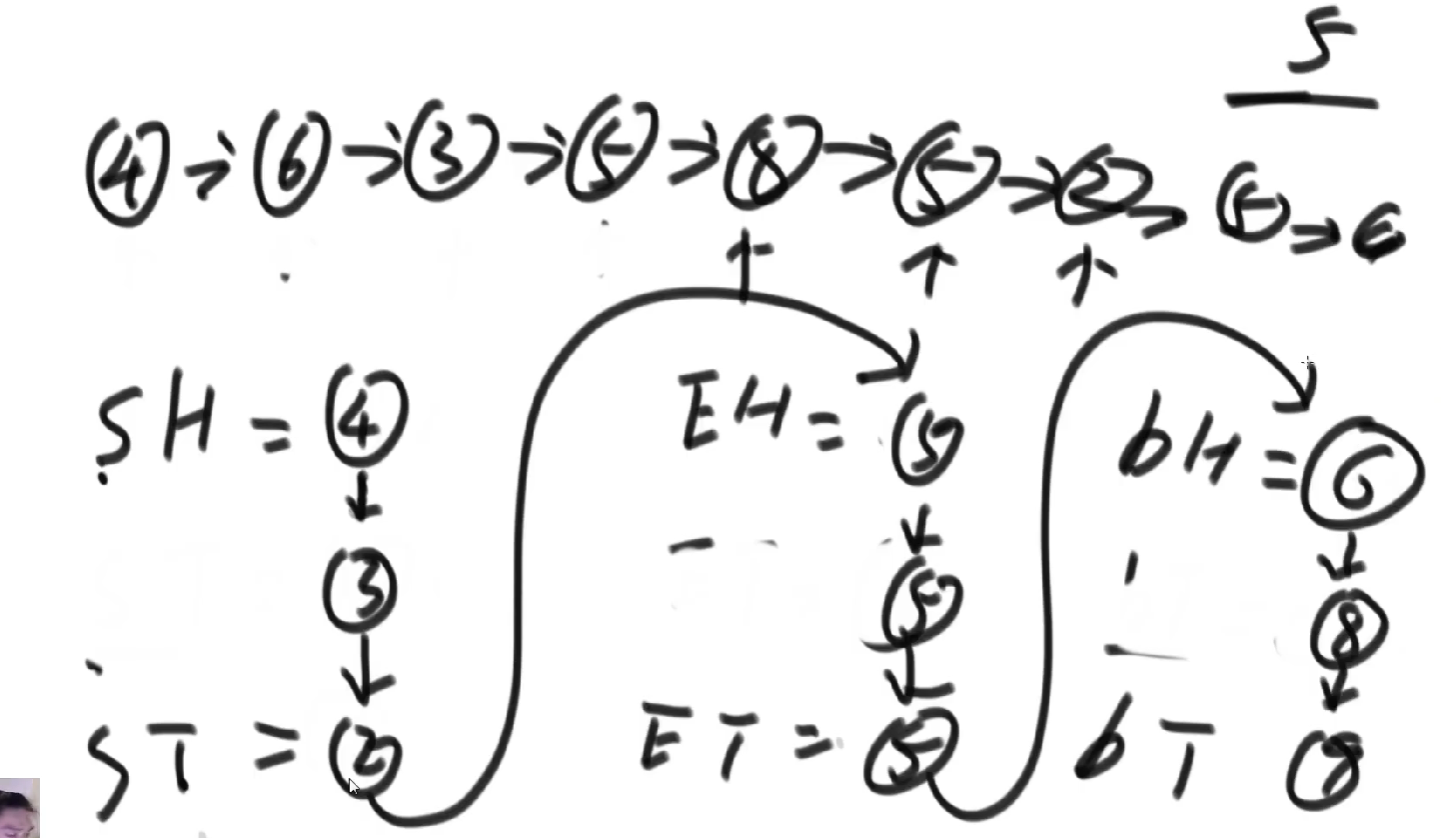
-
单链表环问题
基础:
读链表,把每个节点放到哈希表当中,当出现重复的值就是有环,并返回该相交值,没有则返回null
进阶:
快慢指针,快指针一次走两步,慢指针一次走一步,有环的情况下,快慢指针一定会在环中相遇(且不超过两圈),然后让快指针回到头节点,两个指针再依次往下走,都每次走一步,就会在入环位置相遇
-
两个单链表相交问题
- 找到各自的尾结点并且统计长度
- 如果end节点不相同,则不相交,否则想同
- 长链表先走差值步,然后两个链表同事走,就能找到相交的点
七、二叉树
1.递归序
二叉树的递归遍历一定会让每个节点到达三次,所生成的递归序可用于二叉树的先、中、后序遍历

2.非递归遍历
先序遍历二叉树:
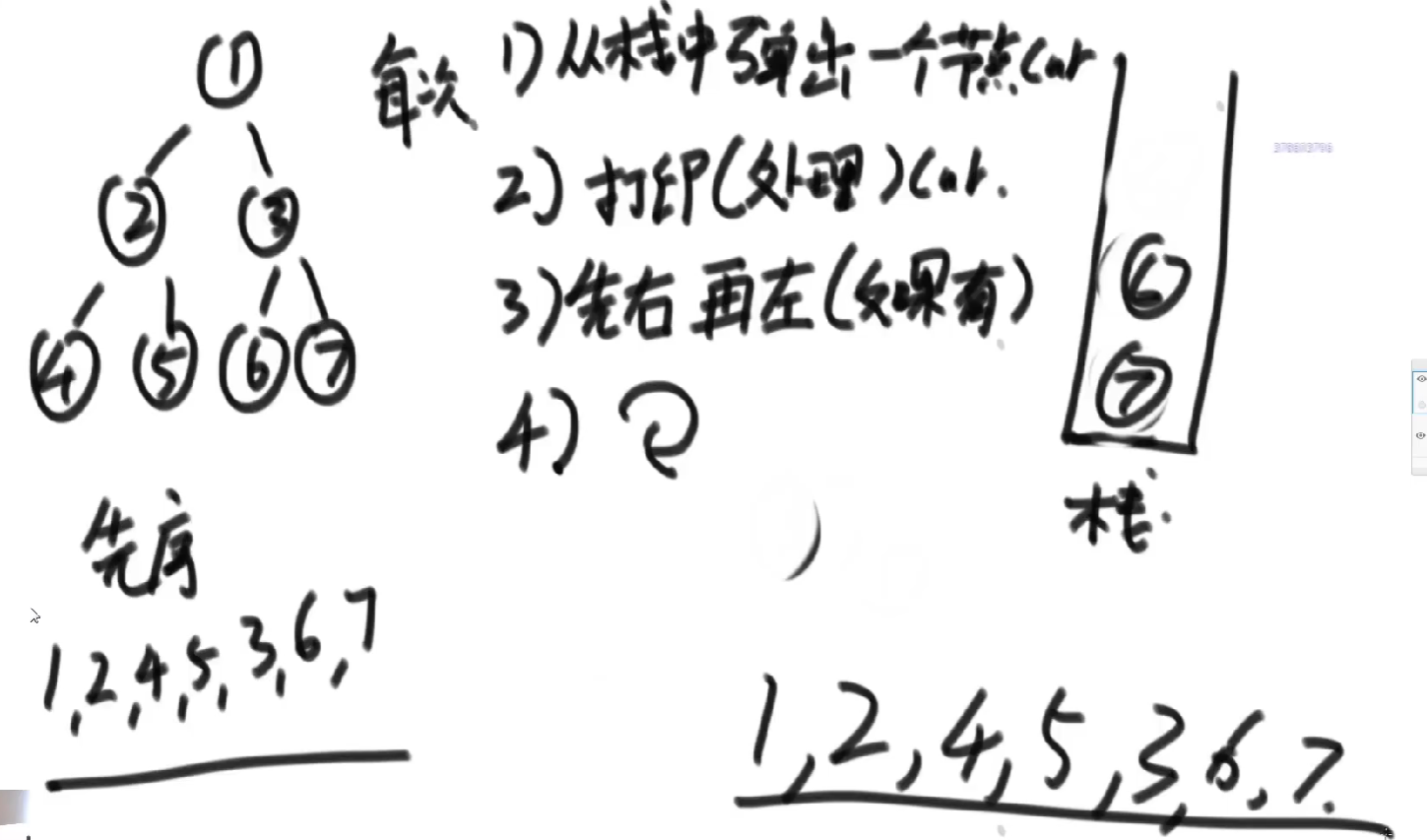
中序遍历二叉树:
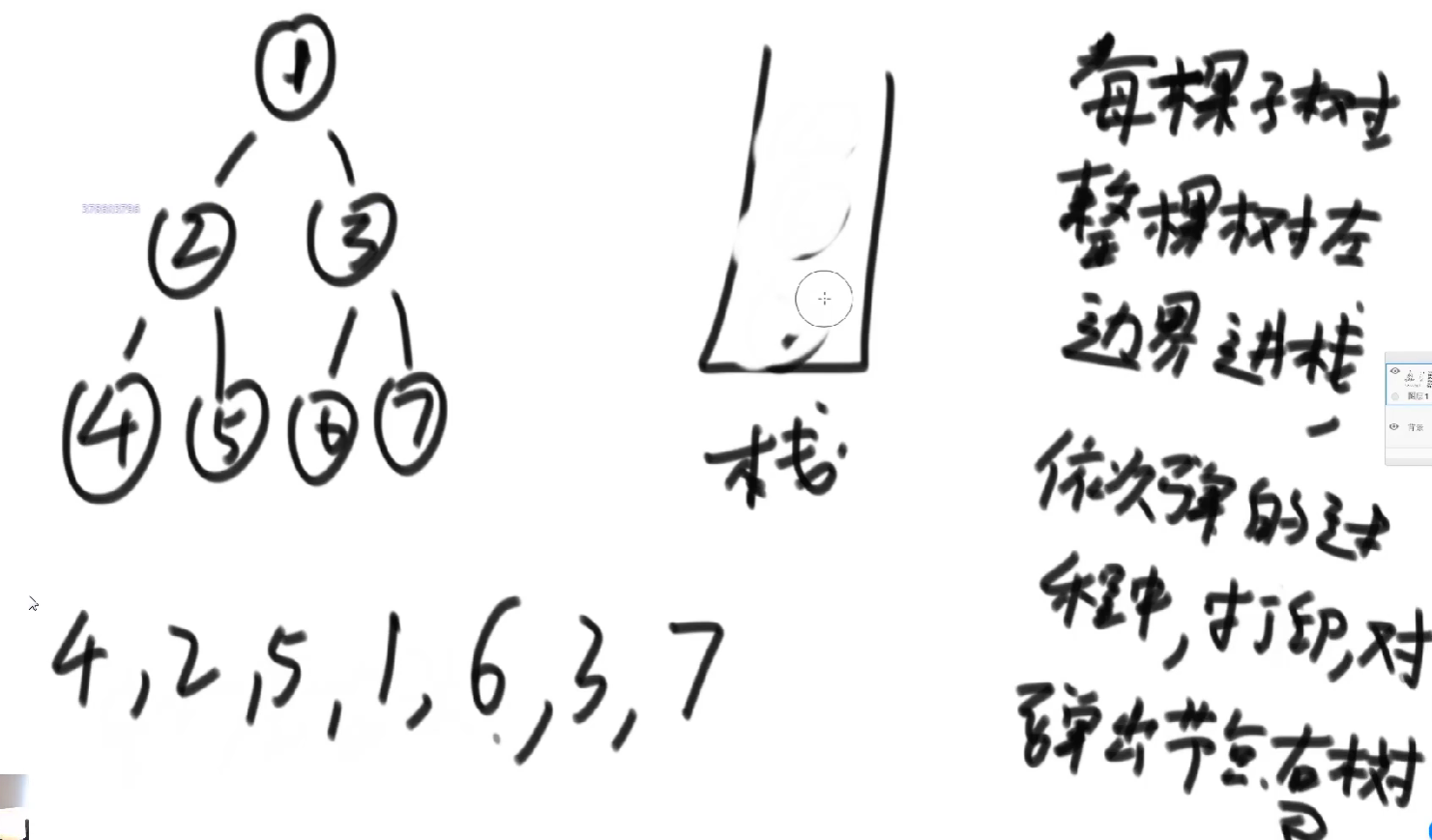
后序遍历二叉树:

代码:
public static void preOrderUnRecur(Node head) {
System.out.print("pre-order: ");
if (head != null) {
Stack<Node> stack = new Stack<Node>();
stack.add(head);
while (!stack.isEmpty()) {
head = stack.pop();
System.out.print(head.value + " ");
if (head.right != null) {
stack.push(head.right);
}
if (head.left != null) {
stack.push(head.left);
}
}
}
System.out.println();
}
public static void inOrderUnRecur(Node head) {
System.out.print("in-order: ");
if (head != null) {
Stack<Node> stack = new Stack<Node>();
while (!stack.isEmpty() || head != null) {
if (head != null) {
stack.push(head);
head = head.left;
} else {
head = stack.pop();
System.out.print(head.value + " ");
head = head.right;
}
}
}
System.out.println();
}
public static void posOrderUnRecur1(Node head) {
System.out.print("pos-order: ");
if (head != null) {
Stack<Node> s1 = new Stack<Node>();
Stack<Node> s2 = new Stack<Node>();
s1.push(head);
while (!s1.isEmpty()) {
head = s1.pop();
s2.push(head);
if (head.left != null) {
s1.push(head.left);
}
if (head.right != null) {
s1.push(head.right);
}
}
while (!s2.isEmpty()) {
System.out.print(s2.pop().value + " ");
}
}
System.out.println();
}
3.层序遍历
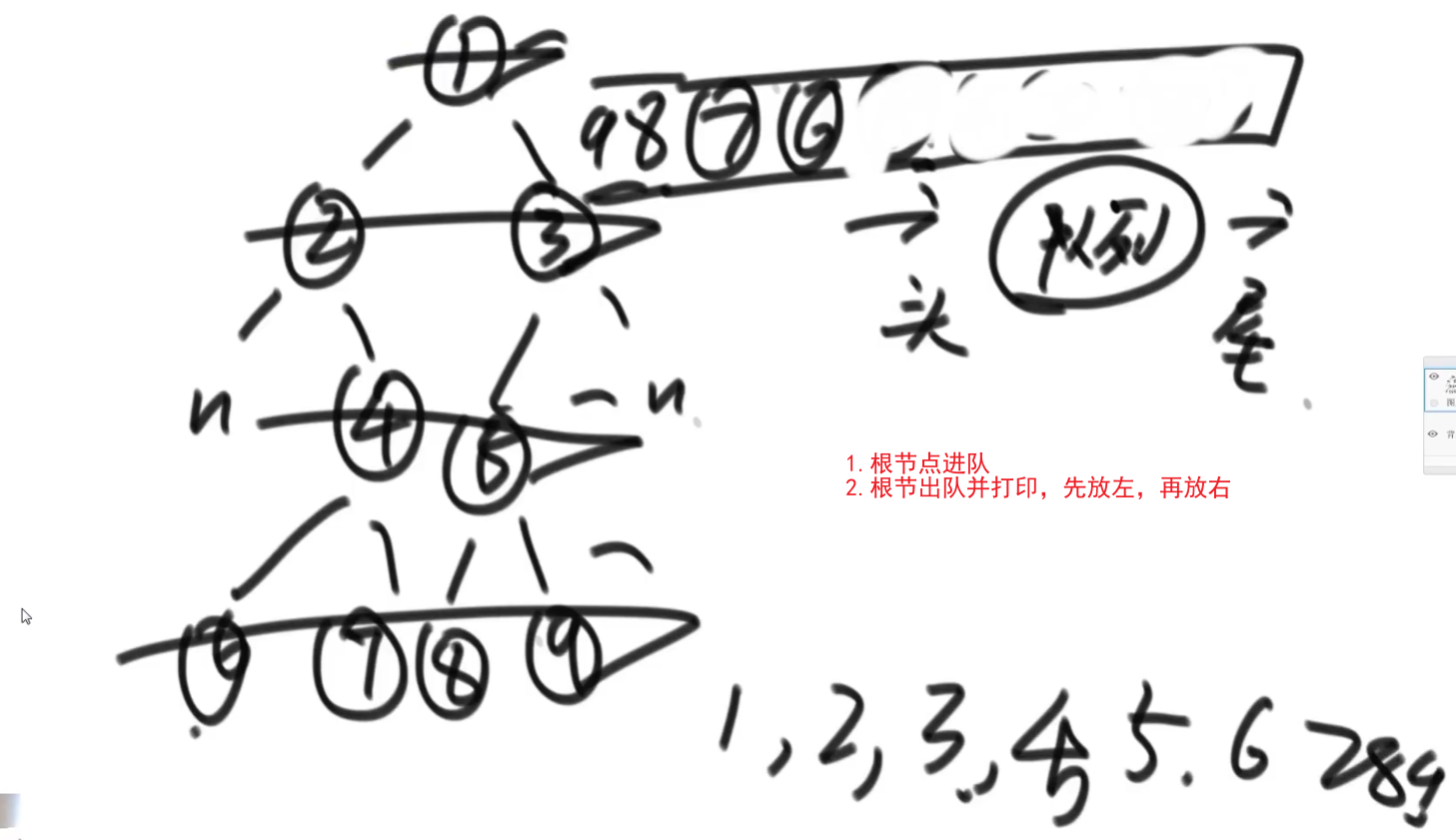
public static void w(Node head){
if(head == null){
return;
}
Queue<Node> queue = new LinkedList<>();
queue.add(head);
while(!queue.isEmpty()){
Node cur = queue.poll();
System.out.println(cur.value);
if(cur.left != null){
queue.add(cur.left);
}
if(cur.right != null){
queue.add(cur.right);
}
}
}
4.搜索二叉树
定义:每一棵子树都是左节点的值小于根节点的值,右节点的值大于根节点的值
快速判断方法:中序遍历,输出的结果是递增的说明就是搜索二叉树
//方法一:静态查找
public static boolean isBST(Node head) {
if (head == null) {
return true;
}
LinkedList<Node> inOrderList = new LinkedList<>();
process(head, inOrderList);
int pre = Integer.MIN_VALUE;
for (Node cur : inOrderList) {
if (pre >= cur.value) {
return false;
}
pre = cur.value;
}
return true;
}
public static void process(Node node, LinkedList<Node> inOrderList) {
if (node == null) {
return;
}
process(node.left, inOrderList);
inOrderList.add(node);
process(node.right, inOrderList);
}
//方法二:动态查找,由递归或者栈打印中序的方法改过来都可以
static int preValue = Integer.MIN;
public static boolean isBST(Node head) {
if (head != null) {
Stack<Node> stack = new Stack<Node>();
while (!stack.isEmpty() || head != null) {
if (head != null) {
stack.push(head);
head = head.left;
} else {
head = stack.pop();
if(head.value<=preValue){
return false;
}else{
preValue = head.value;
}
head = head.right;
}
}
}
System.out.println();
}
5.完全二叉树

public static boolean isCBT(Node head) {
if (head == null) {
return true;
}
LinkedList<Node> queue = new LinkedList<>();
boolean leaf = false;
Node l = null;
Node r = null;
queue.add(head);
while (!queue.isEmpty()) {
head = queue.poll();
l = head.left;
r = head.right;
if (
//遇到不双全的节点之后,又发现当前节点不是叶节点
(leaf && (l != null || r != null))
||
(l == null && r != null)//有右无左
) {
return false;
}
if (l != null) {
queue.add(l);
}
if (r != null) {
queue.add(r);
} else {
leaf = true;
}
}
return true;
}
6.满二叉树
如何判断:得到树的最大深度L和节点数N,当满足N=2^L-1,则为满二叉树
7.平衡二叉树
对于任何一棵树,左树的高度与右树的高度差不超过1
8.算法题
-
二叉树的序列化和反序列化
就是内存里的一棵树如何变成字符串形式,又如何从字符串形式变成内存里的树
做法:做先序遍历,节点结束以下划线隔开,子树为空就用#代替
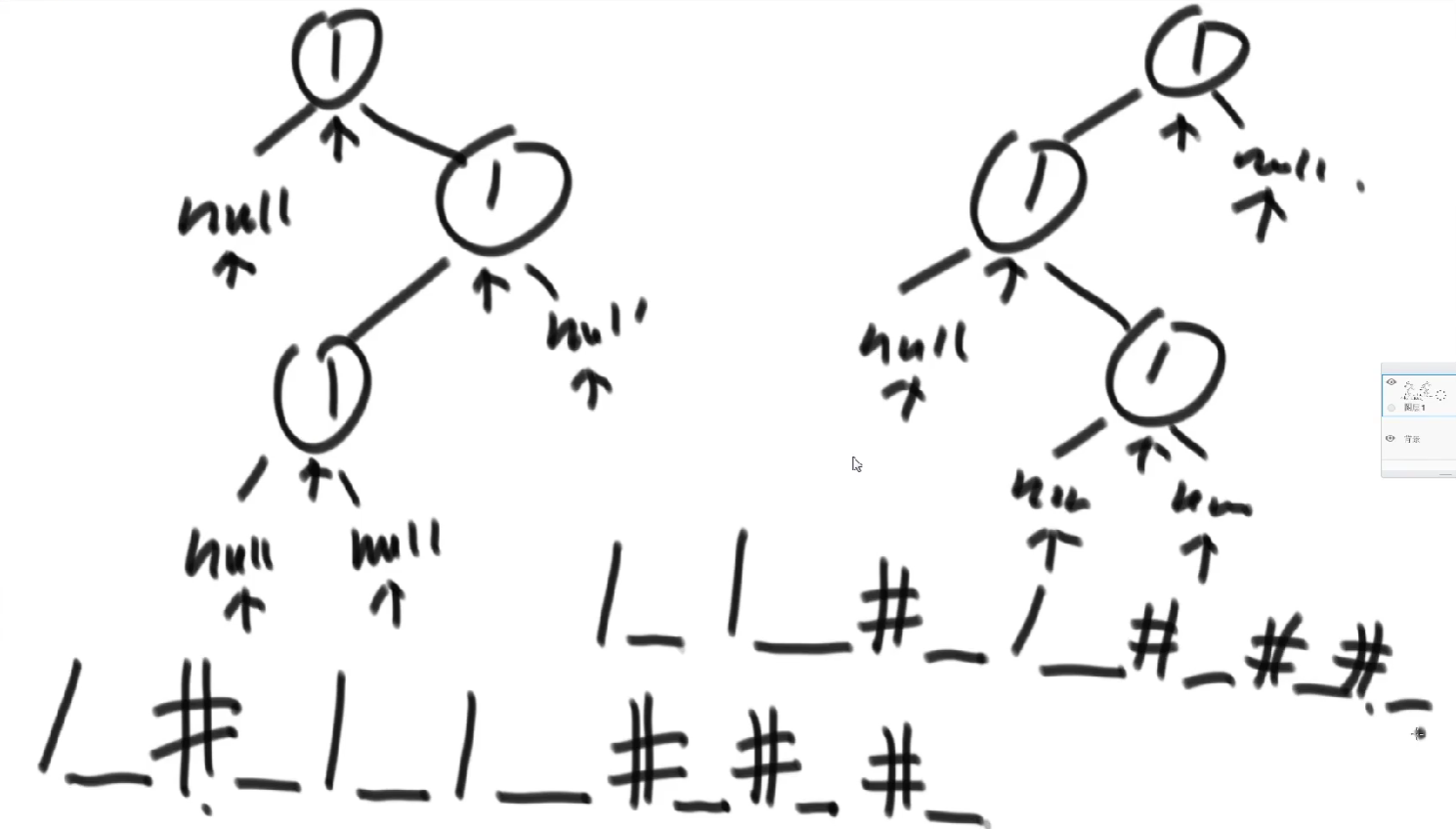
八、图
1.宽度优先遍历
public static void bfs(Node node) {
if (node == null) {
return;
}
//队列
Queue<Node> queue = new LinkedList<>();
//set记录表
HashSet<Node> map = new HashSet<>();
queue.add(node);
map.add(node);
while (!queue.isEmpty()) {
Node cur = queue.poll();
//要怎么处理
System.out.println(cur.value);
for (Node next : cur.nexts) {
if (!map.contains(next)) {
map.add(next);
queue.add(next);
}
}
}
}
2.深度优先遍历
public static void dfs(Node node) {
if (node == null) {
return;
}
Stack<Node> stack = new Stack<>();
HashSet<Node> set = new HashSet<>();
stack.add(node);
set.add(node);
System.out.println(node.value);
while (!stack.isEmpty()) {
Node cur = stack.pop();
for (Node next : cur.nexts) {
if (!set.contains(next)) {
stack.push(cur);
stack.push(next);
set.add(next);
System.out.println(next.value);
break;
}
}
}
}
3.最小生成树
-
什么是最小生成树
- 无向图来的
- 保证点的联通性
- 边的权值是最小的

-
怎么生成
算法一:kruskal(卡鲁斯卡尔)算法
-
取出所有的点,所有的边,每条边一个集合
-
从最小的边开始放,先放2,看有没有生成环,没有,再放3,看有没有生成环,没有,在放5,没有环,再放7,放7有环,不放,放100有环,不放...
怎么判断有环无环?
并查集
每个边一条集合,放入一条边的时候看from点的集合里是否有to点,没有则没有环,并且合并from,to点集合为一个集合
算法二:prim(普利姆)算法
-
4.Dijkstra算法
-
适用范围:没有权值为负数的边
-
定义:必须有一个起点,生成起点到每个点最短距离的表
-
演示:过程解说 第1:59:20处
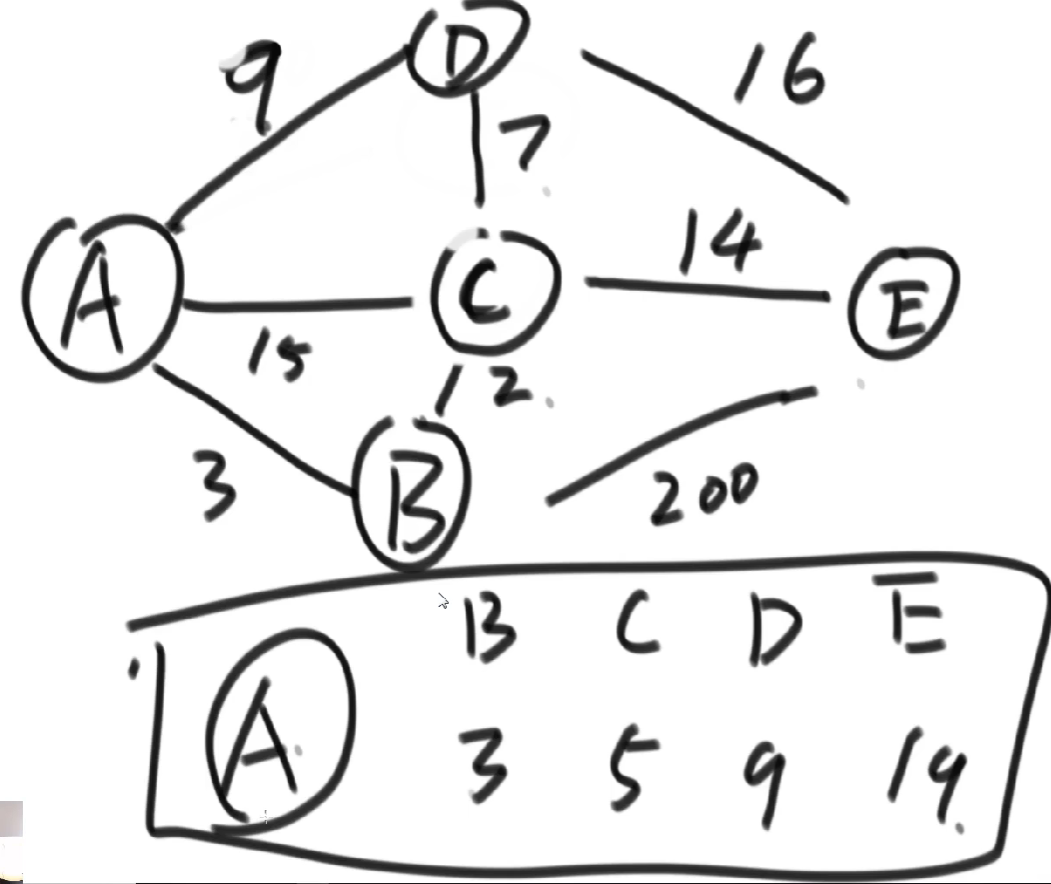
N、补充知识
1.比较器
一个学生对象,按照id的升序排序
public static class Student {
public String name;
public int id;
public int age;
public Student(String name, int id, int age) {
this.name = name;
this.id = id;
this.age = age;
}
}
写一个比较器:
public static class IdAscendingComparator implements Comparator<Student> {
//返回负数的时候,第一个参数排在最前面
//返回正数的时候,第二个参数排在前面
//返回0的时候,谁在前无所谓
@Override
public int compare(Student o1, Student o2) {
return o1.id - o2.id;
}
}
//调用排序
Arrays.sort(students, new IdAscendingComparator());
